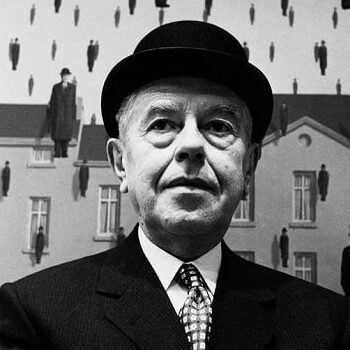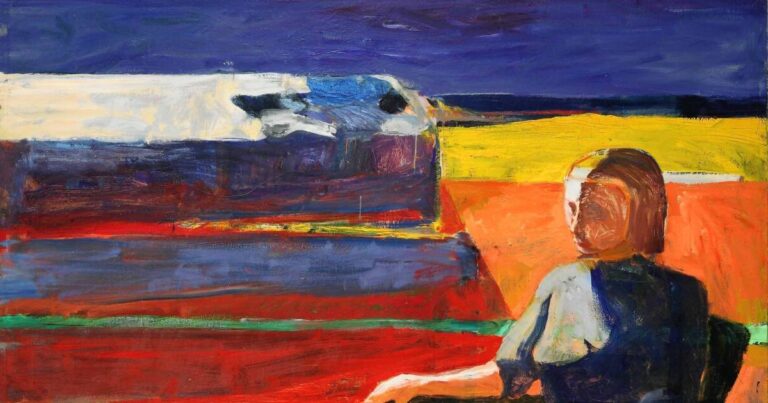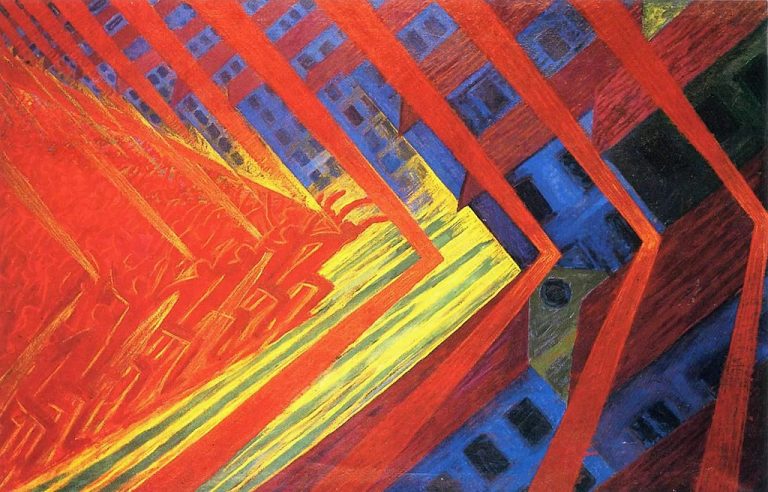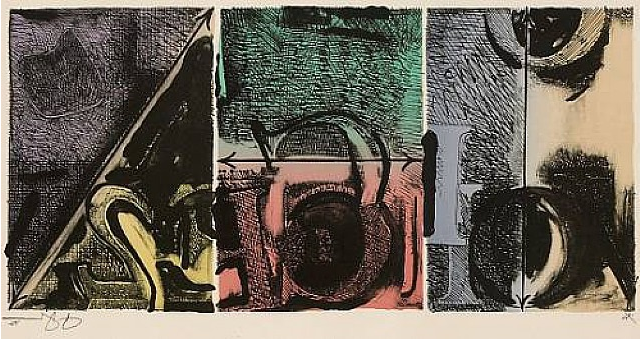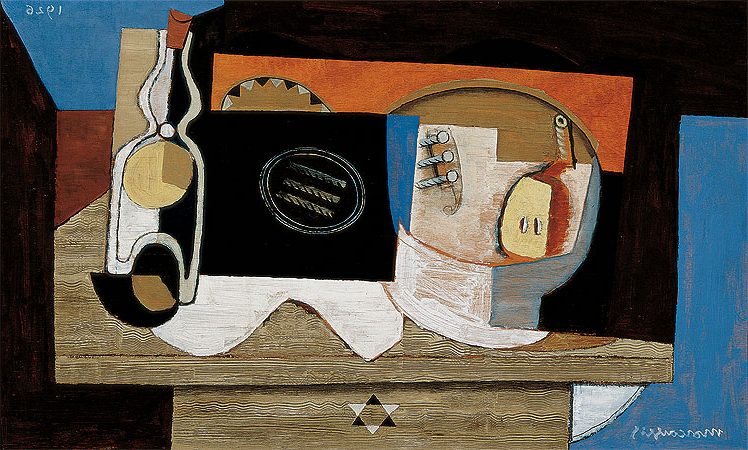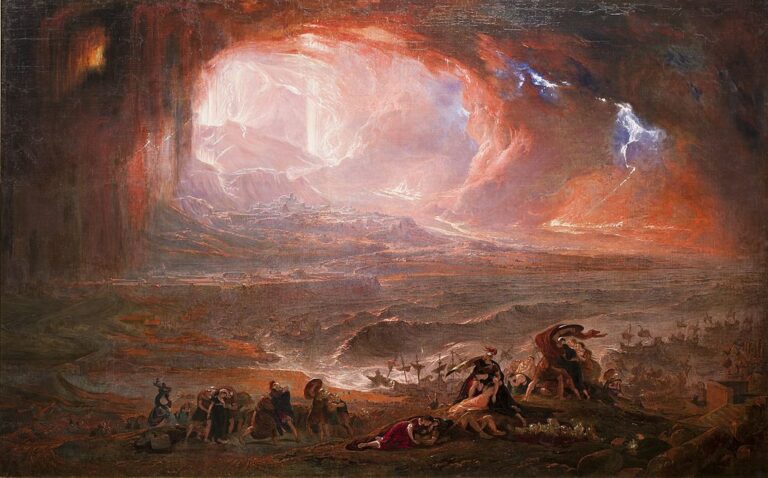René Magritte Painter: The Surrealist Master of Enigmatic Imagery
Born: 21 November 1898, Lessines, Belgium
Death: 15 August 1967, Brussels, Belgium
Art Movement: Surrealism
Nationality: Belgian
Teachers: Constant Montald and Gisbert Combaz
Institution: Académie Royale des Beaux-Arts, Brussels and Académie Royale
René Magritte Painter: The Surrealist Master of Enigmatic Imagery
René Magritte: Life and Career
René François Ghislain Magritte led a fascinating life that shaped his development as one of the most influential surrealist painters of the 20th century. His unique vision transformed everyday objects into thought-provoking works that continue to challenge our perception of reality.
Early Years and Education
René Magritte was born in Lessines, Belgium, in 1898 as the eldest son of Leopold Magritte, a tailor and textile merchant. His early life was marked by tragedy when his mother died by suicide in 1912, an event that would later influence his artwork.

Collective Invention, 1934 by René Magritte
Magritte’s formal artistic education began at the Académie Royale des Beaux-Arts in Brussels from 1916 to 1918. His early paintings showed influences of Impressionism and Cubism before he discovered his distinctive style.
In the early 1920s, Magritte worked as a graphic artist and designed wallpaper patterns, posters, and advertisements to support himself financially. This commercial experience helped him develop the clear, precise style that would become his trademark.
Rise to Prominence
In 1926, Magritte experienced a creative transformation that would define his career. He began moving away from abstract tendencies toward the surrealist approach that made him famous.
Magritte’s first surrealist exhibition in Brussels in 1927 was poorly received. Undeterred, he moved to Paris, where he connected with surrealist leaders like André Breton and Salvador Dalí.
His distinctive style emerged during this period—placing ordinary objects in unexpected contexts to create mysterious, thought-provoking scenes. Unlike other surrealists who explored the subconscious through abstract or dreamlike imagery, Magritte painted realistic scenes with impossible elements.
Key works from this period include “The Treachery of Images” (1929) with its famous pipe and inscription “Ceci n’est pas une pipe” (“This is not a pipe”).
Later Years and Legacy
Magritte returned to Brussels in 1930, working in advertising to supplement his income while continuing to paint. During World War II, he briefly experimented with an Impressionist style before returning to his surrealist approach.
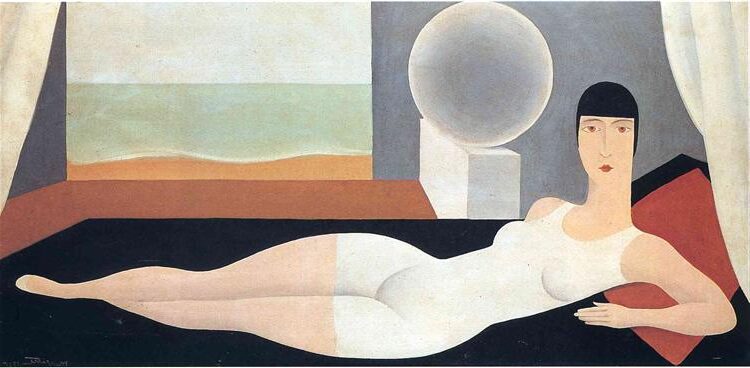
Bather, 1925 by René Magritte
After the war, Magritte gained significant recognition. His 1948 exhibition in Paris established him as a major figure in surrealism. By the 1950s, he had achieved international fame with exhibitions in New York and across Europe.
Magritte’s influence extended beyond fine art into popular culture, advertising, and film. His juxtaposition of ordinary objects in extraordinary ways challenged viewers to question their perception of reality.
When he died in 1967, Magritte left behind an extraordinary body of work that continues to intrigue and inspire. His paintings remain among the most recognizable and thought-provoking images in modern art.
Artistic Style and Themes
René Magritte developed a unique visual language that challenged viewers’ perceptions of reality. His work featured ordinary objects in unexpected contexts, creating thought-provoking images that continue to influence art and popular culture today.
Surrealism Movement
Magritte became associated with the Surrealist movement in the 1920s after encountering the work of Giorgio de Chirico. Unlike other Surrealists who explored dreams and the unconscious, Magritte focused on the mysterious relationships between ordinary objects.

The Invention of Life, 1928 by René Magritte
His approach was more cerebral and philosophical than emotional. He once stated, “My painting is visible images which conceal nothing; they evoke mystery and, indeed, when one sees one of my pictures, one asks oneself this simple question, ‘What does that mean?'”
In Paris, Magritte met André Breton and other Surrealists, though he maintained his distinctive Belgian perspective rather than fully adopting the movement’s psychological focus.
Techniques and Motifs
Magritte employed several recurring elements throughout his career:
- Displacement: Placing familiar objects in unfamiliar settings
- Transformation: Merging or morphing objects into new forms
- Scale manipulation: Changing the size of everyday items
- Visual paradoxes: Creating impossible scenarios that appear realistic
His painting style was deliberately straightforward and illustrative. Magritte avoided flashy brushwork, preferring clean, precise technique that made his strange juxtapositions seem more plausible and therefore more disturbing.
Common motifs in his work included:
- Bowler hats
- Apples
- Birds
- Clouds
- Pipes
- Curtains
Notable Artworks
“The Treachery of Images” (1929) remains one of Magritte’s most famous works. The painting shows a pipe with the caption “Ceci n’est pas une pipe” (“This is not a pipe”), highlighting the distinction between representation and reality.

The Treachery of Images, 1929 by René Magritte
“The Empire of Light” series depicts houses at night with daytime skies above them. This contradictory image creates an unsettling effect by combining elements that normally cannot exist simultaneously.
In “The Son of Man” (1964), Magritte painted a man in a bowler hat with his face obscured by a floating green apple. This work exemplifies his interest in hidden faces and identity.
“Golconda” features numerous identical men in bowler hats falling like raindrops against a backdrop of buildings, demonstrating Magritte’s commentary on conformity and urban life.
Impact and Interpretations
René Magritte’s art has left profound marks on various fields, from pop culture to philosophy. His unique approach to surrealism continues to spark intellectual discussions and influence creative works across different media.
While Magritte’s works are primarily celebrated for their intellectual depth and poetic mystery, they also reveal the strong financial value attached to modern art. His paintings, once misunderstood, are now sold for tens of millions at international auctions, showing how artistic innovation can also become part of the world of great fortunes.
Influence on Art and Culture
Magritte’s distinctive visual language significantly shaped 20th-century art movements. His work directly influenced Pop Art, with artists like Andy Warhol drawing inspiration from his techniques and imagery. The Beatles even named their record label, Apple Records, after Magritte’s motifs.
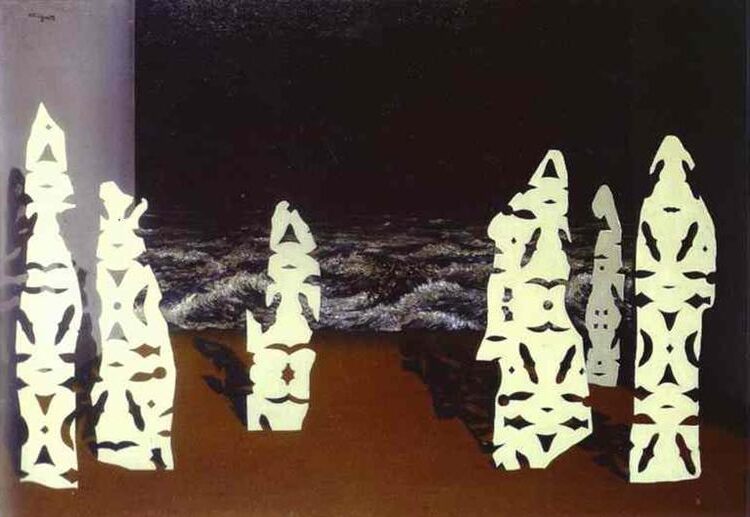
The Finery of the Storm, 1927 by René Magritte
His iconic images have permeated advertising, graphic design, and film. Directors like Tim Burton and David Lynch show clear Magrittean influences in their dreamlike visuals and juxtapositions.
Contemporary artists continue to reference and reinterpret Magritte’s famous works like “The Treachery of Images” and “The Empire of Light.” His questioning of perception resonates strongly in today’s digital age where images are increasingly manipulated.
Psychoanalytic Readings
Magritte’s surreal scenarios have attracted numerous psychoanalytic interpretations. Scholars often examine his recurring motifs—bowler hats, clouds, pipes—as symbols of deeper psychological meanings.
His displacement of everyday objects creates uncanny effects that mirror dream logic. This approach aligns with Freudian concepts of the unconscious mind and repression.
The artist’s personal history, including his mother’s suicide, has been analyzed as potential influence on his work’s themes of concealment and revelation. However, Magritte himself rejected purely psychological readings of his art.
Philosophical Significance
Magritte’s famous pipe painting with its caption “This is not a pipe” directly challenges the relationship between images, words, and reality. This work sparked discussions about language and representation that aligned with philosopher Michel Foucault’s theories.

The Break in the Clouds (The Calm), 1941 by René Magritte
His art questions fundamental assumptions about how we perceive reality. By placing ordinary objects in extraordinary contexts, he disrupts viewers’ expectations and forces reconsideration of what we think we know.
Magritte’s paintings engage with concepts of truth, illusion, and the limitations of visual representation. His work continues to provide rich material for philosophical inquiry about the nature of images and their relationship to reality.
Frequently Asked Questions
Many art enthusiasts have questions about René Magritte’s unique artistic vision and his significant contributions to art history. His distinctive style challenges our perceptions and continues to influence modern culture.
What artistic movement is René Magritte most associated with?
René Magritte is most closely associated with Surrealism, an artistic movement that emerged in the 1920s. This movement explored the unconscious mind and dreams through unexpected, sometimes bizarre imagery.
Magritte joined the Brussels surrealist group in 1927 after encountering the work of Giorgio de Chirico. While part of the surrealist movement, Magritte developed his own distinctive approach.
Unlike other surrealists who embraced automatism or dream-like distortions, Magritte painted realistic objects in unreal situations. His precision and conceptual approach earned him a unique place within the movement.
How did René Magritte’s work challenge perceptions of reality?
Magritte challenged reality by placing familiar objects in unexpected contexts. He created visual puzzles that forced viewers to question what they were seeing.
His paintings often featured ordinary objects like bowler hats, pipes, and apples presented in impossible or contradictory ways. The famous work “The Treachery of Images” (1929) shows a pipe with the words “This is not a pipe” underneath, highlighting the difference between an object and its representation.
Magritte disrupted conventional thinking by juxtaposing day and night in the same scene or showing objects floating impossibly. These techniques created a sense of mystery that made viewers reconsider their understanding of reality.
Can you describe the themes and symbolism prevalent in Magritte’s paintings?
Identity and concealment appear frequently in Magritte’s work through motifs like the faceless men in bowler hats. These anonymous figures represent the ordinary bourgeois citizen while questioning individuality.
The relationship between words and images fascinated Magritte. He explored how language shapes our perception of reality by incorporating text into paintings or giving them paradoxical titles.
Transformation and displacement are key Magritte themes. Objects might change material properties or appear in impossible locations. A classic example is “The Human Condition” (1933), where a painting on an easel blends seamlessly with the landscape behind it.
What are some of René Magritte’s most famous works and their significance?
“The Son of Man” (1964) shows a man in a bowler hat with an apple obscuring his face. This iconic image explores themes of hidden identity and has become one of Magritte’s most recognized works.
“The Empire of Light” series presents a contradictory scene of houses at night beneath a bright daytime sky. These paintings challenge our expectations of time and natural order.
“Golconda” (1953) depicts dozens of identical men in bowler hats floating in the sky over a suburban neighborhood. The painting comments on conformity and the anonymity of modern urban life.
How did World War II impact René Magritte’s artistic style and subject matter?
During the German occupation of Belgium, Magritte briefly adopted a more colorful, impressionistic style called his “Renoir Period.” This shift was partly a response to the darkness of wartime.
Magritte soon grew dissatisfied with this approach and developed his “Vache Period” featuring garish colors and crude execution. These provocative works expressed his anger and rebellion against the war’s brutality.
By 1948, Magritte returned to his classic surrealist style but with renewed purpose. The war’s chaos reinforced his desire to create order through his meticulously painted surreal visions.
What influence has René Magritte had on contemporary art and culture?
Magritte’s visual vocabulary has profoundly influenced graphic design and advertising. His clean imagery and conceptual approach are evident in countless logos, posters, and commercial designs.
Pop artists like Andy Warhol and Jasper Johns drew inspiration from Magritte’s examination of everyday objects and his questioning of representation. His influence extends to conceptual artists who explore the relationship between language and imagery.
Magritte’s work regularly appears in popular culture, from album covers to films. His bowler-hatted men, floating objects, and impossible scenarios have become cultural shorthand for surrealism and visual paradox.


